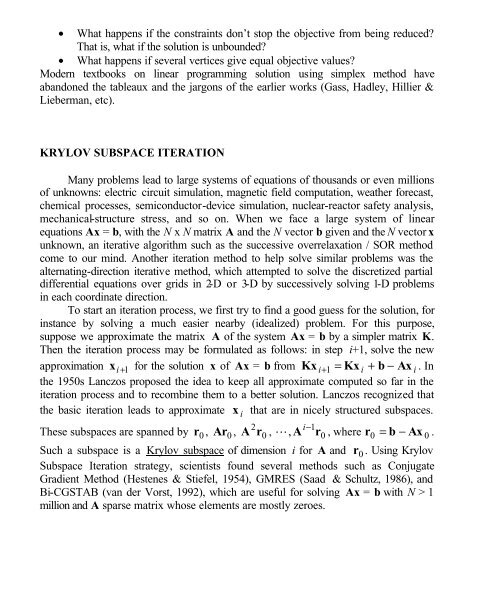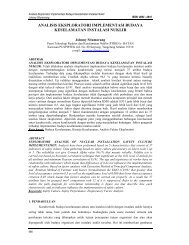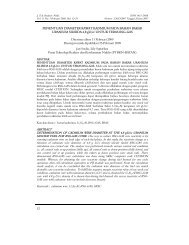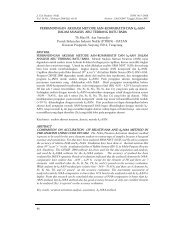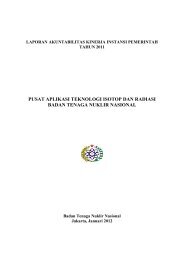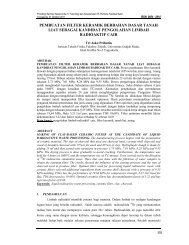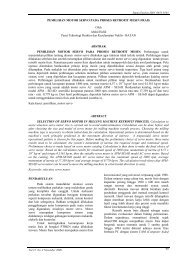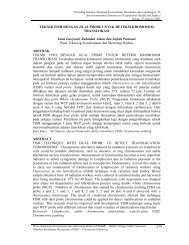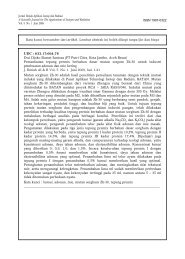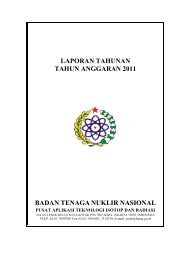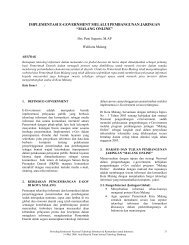THE TOP 10 ALGORITHMS OF THE 20TH CENTURY M ... - Batan
THE TOP 10 ALGORITHMS OF THE 20TH CENTURY M ... - Batan
THE TOP 10 ALGORITHMS OF THE 20TH CENTURY M ... - Batan
You also want an ePaper? Increase the reach of your titles
YUMPU automatically turns print PDFs into web optimized ePapers that Google loves.
• What happens if the constraints don’t stop the objective from being reduced?<br />
That is, what if the solution is unbounded?<br />
• What happens if several vertices give equal objective values?<br />
Modern textbooks on linear programming solution using simplex method have<br />
abandoned the tableaux and the jargons of the earlier works (Gass, Hadley, Hillier &<br />
Lieberman, etc).<br />
KRYLOV SUBSPACE ITERATION<br />
Many problems lead to large systems of equations of thousands or even millions<br />
of unknowns: electric circuit simulation, magnetic field computation, weather forecast,<br />
chemical processes, semiconductor-device simulation, nuclear-reactor safety analysis,<br />
mechanical-structure stress, and so on. When we face a large system of linear<br />
equations Ax = b, with the N x N matrix A and the N vector b given and the N vector x<br />
unknown, an iterative algorithm such as the successive overrelaxation / SOR method<br />
come to our mind. Another iteration method to help solve similar problems was the<br />
alternating-direction iterative method, which attempted to solve the discretized partial<br />
differential equations over grids in 2-D or 3-D by successively solving 1-D problems<br />
in each coordinate direction.<br />
To start an iteration process, we first try to find a good guess for the solution, for<br />
instance by solving a much easier nearby (idealized) problem. For this purpose,<br />
suppose we approximate the matrix A of the system Ax = b by a simpler matrix K.<br />
Then the iteration process may be formulated as follows: in step i+1, solve the new<br />
approximation x i + 1 for the solution x of Ax = b from Kx i+1<br />
= Kx i + b − Ax i . In<br />
the 1950s Lanczos proposed the idea to keep all approximate computed so far in the<br />
iteration process and to recombine them to a better solution. Lanczos recognized that<br />
the basic iteration leads to approximate x i that are in nicely structured subspaces.<br />
2 1<br />
These subspaces are spanned by r 0 , Ar 0 , A r0<br />
, , A r0<br />
− i<br />
L , where r0 = b − Ax 0 .<br />
Such a subspace is a Krylov subspace of dimension i for A and r 0 . Using Krylov<br />
Subspace Iteration strategy, scientists found several methods such as Conjugate<br />
Gradient Method (Hestenes & Stiefel, 1954), GMRES (Saad & Schultz, 1986), and<br />
Bi-CGSTAB (van der Vorst, 1992), which are useful for solving Ax = b with N > 1<br />
million and A sparse matrix whose elements are mostly zeroes.


